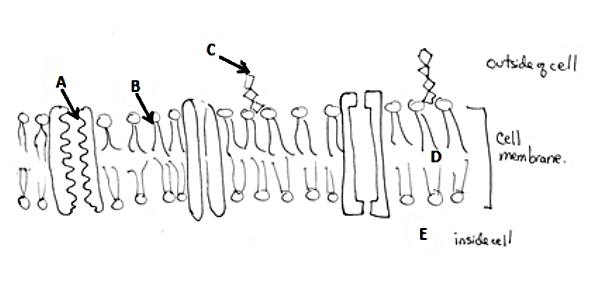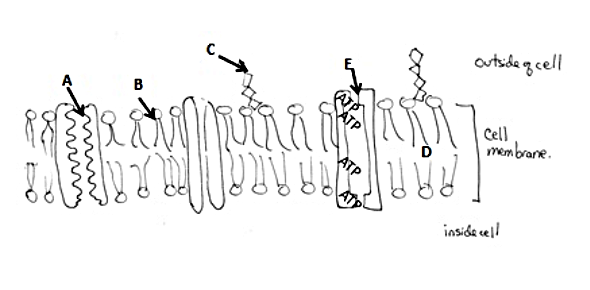Parts Of A Cell Membrane

Parts of a cell membrane and movement through the membrane.
- 1.
If an animal cell is placed in a hypotonic solution, what will happen?
- A.
It will shrink when water leaves the cell through osmosis.
- B.
It will swell as water enters the cell through osmosis.
- C.
It will stay the same size, no activity will happen.
- D.
It may burst or shrink, it depends on the temperature.
Correct Answer
B. It will swell as water enters the cell through osmosis.Explanation
A cell SWELLS (like a HIPPO) in a HYPOtonic solution.Rate this question:
-
- 2.
A specific molecule is able to be transported by facilitated diffusion, which part of the cell membrane would a molecule pass through?
- A.
A
- B.
B
- C.
C
- D.
D
Correct Answer
A. AExplanation
Facilitated diffusion: No energy needed, but can not fit through the phospholipid bilayer. It needs to go through the protein channels. A is a protein channel. IMPORTANT: DIFFERENT SUBSTANCES NEED TO GO THROUGH DIFFERENT CHANNELSRate this question:
-
- 3.
What is the purpose of C?
- A.
It is an area for facilitated diffusion
- B.
It is an identity marker for the cell. For example, each cell of the human body as a marker, so the immune system can tell self from non-self.
- C.
It is an area for osmosis
- D.
It has no known function.
Correct Answer
B. It is an identity marker for the cell. For example, each cell of the human body as a marker, so the immune system can tell self from non-self.Explanation
Carbohydrate "marker" : Identifies cellsRate this question:
-
- 4.
What part of the cell is for transport of very small particles - without energy needed:?
- A.
A
- B.
B
- C.
C
Correct Answer
B. BExplanation
Very small particles can diffuse (no energy) through the phospholipid bilayer.Rate this question:
-
- 5.
Which area of the cell membrane is for pumping ions (for example, Sodium and Potassium ions) against the concentration gradient?
- A.
A
- B.
B
- C.
D
- D.
E
Correct Answer
D. EExplanation
A pump is used to move substances (example: ions) against the concentration gradient (low to high). It can be distinguished in this picture by the presence of ATP. ATP is the molecule used by the cell for energy.Rate this question:
-
- 6.
What part of the cell membrane is hydrophobic?
- A.
D
- B.
E
Correct Answer
A. DExplanation
The phospholipid "tails" are hydrophobic - they are "hiding" (phobic = afraid) away from the watery environment of the cell.Rate this question:
-
Quiz Review Timeline +
Our quizzes are rigorously reviewed, monitored and continuously updated by our expert board to maintain accuracy, relevance, and timeliness.
-
Current Version
-
Aug 07, 2024Quiz Edited by
ProProfs Editorial Team -
Oct 30, 2013Quiz Created by
Kwchiro







